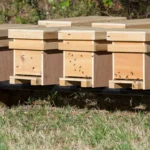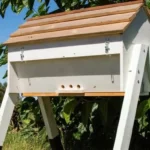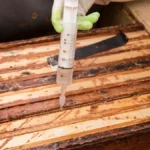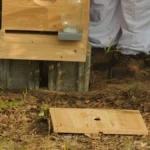In this article, we will take a look at the Warre hive vs Langstroth hive. Both are excellent hive tyes, and each has its place. This comparison of the Warre hive vs Langstroth hive will allow you to choose what works best for you.
Since ancient times there have been attempts to develop beehives that allow the beekeeper to produce honey more efficiently. We have seen people use clay pot hives (my high school friend Richard is developing a special clay pot beehive for mead makers), hollow bark tubes (My friends Dan and Barb have one of the bigger honey companies in Africa that use these), basket skeps, boxes with sticks in them, and many other contraptions.
In the mid-1800s the Reverend Langstroth came up with his design, which is now called the Langstroth Beehive. If we look at any technology it goes through a series of stages. Beekeeping is a method of farming bees using technology. There are countless technologies that people invent, and some of these become successfully adopted, and some don’t.
The Langstroth hive was an appropriate technology, invented at exactly the right time, and the Reverend was the right guy to promote his technology. Rapid technology and population growth meant that new ways of doing things were needed. Increasingly industrial farming required more pollination. Moving bees around by train, boat (paddle steamers on the Mississippi in the 1800s were such an experimental mobile apiary) or cart became important to industrial farming. To do this, the Langstroth hive was the perfect scalable industrial beekeeping technology. This does not mean it was the perfect hive – it was just appropriate for certain industrial beekeeping applications.
How Does A Langstroth Hive Work?
A Langstroth hive is a modular beehive that employs bee space to direct the bees to make combs where they are needed. It is designed to be easily loaded and unloaded. Boxes can be stacked on trucks, trains, boats, or even pallets moved by helicopters. The design of the hive allows boxes to fit close together.
Combs in the Langstroth hive are drawn into frames that can be reinforced with plastic or wire. This means that the hive can be moved and the combs will not break off. It also means you can remove combs filled with honey and spin the honey out of these combs. The empty combs can be replaced in the hive to be refilled.
If you have thousands or even hundreds of hives and you have to move them around for pollination or to chase honey flows, when comparing the Warre hive vs Langstroth hive, the Langstroth hive is the hive for you. It is modular, standardized, robust, and relatively easy to work with. This does not however mean it is the perfect beehive for all applications. It is just a good, easy-to-use design that has become a global standard.
Read more about Deep Hive Body Dimensions
Other Hive Designs
Every year, beekeepers invent new hive designs. Entrepreneurs always believe in their own mythology, and each new invention is the “big disruptive technology” that will revolutionize beekeeping. I have over the years seen these designs come and go.
Many of the designs have been amazing – I remember one where the entire supers were removed as a cast plastic unit – the extractor took the entire super and, together with 10 others, spun out a huge amount of honey very quickly. This system worked beautifully – and it never made it into a single other beekeeper’s operation.
The reason for this is that humans are resistant to change and we just tend to do things “the way it works”. In the backyard beekeeping domain, we can be more experimental and play with new ideas that come out or test old ideas that never quite gained traction.
There are a few of these innovations that I personally like. Generic Top Bar Hives have their place. A relatively new technologically dense “hive invention” is the Flow Hive. When this came out my gut feeling was it was a silly gimmick – it is actually not and is quite amazing. A friend has one, and it works and is a whole lot of fun. Again, hats off to the inventors.
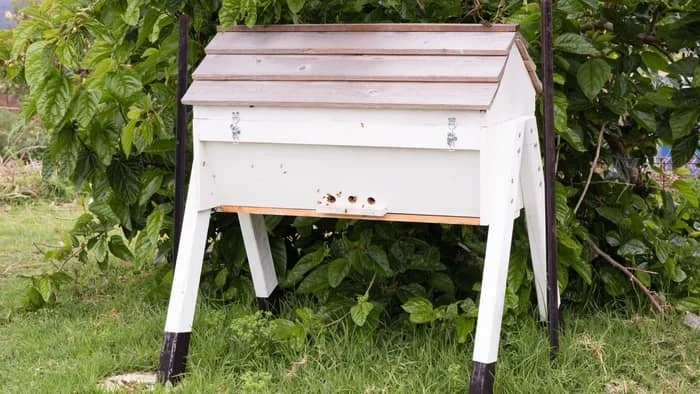
The Warre hive is an interesting technology that is slowly gaining traction in the hobby and backyard beekeeping circles. I personally like these hives – not enough that I would actually build one, but enough that when somebody gave me one I did not give it away.
What Is The Warre Hive?
The Warre hive is basically a type of Top Bar hive designed to be very simple to use. The original design of the hive was conceived by Émile Warré – a French priest. He called it “The Peoples Beehive”. The idea was to design a really simple foolproof system that could easily be manufactured. It was also supposed to be easily used and not require much manipulation.
Let us unpack this comparing the Warre hive vs Langstroth hive. With a Langstroth hive, you need to perform hive manipulations to keep the hive productive. Every year or two you need to replace a few frames in the brood nest to limit the build-up of super dark combs. There are countless manipulations that we perform to keep our Langstroth hives functional. Without these, the hives are a lot less productive.
The Warre hive consists of a series of identical boxes. Comparing the Warre hive vs Langstroth hive, these boxes are smaller than Langstroth boxes. This helps for conserving your spinal column. With the Warre hive system, we remove full boxes of honey from the top of the hive and introduce empty boxes at the bottom. The bees draw the combs at the bottom and move the brood nest down onto fresh combs. Fresh combs have very few diseases and poisons building up in the comb and the bees flourish.
The brood nest has now moved up a level, and these combs will have the brood cycle hatch, and then be filled with honey eventually. When the box reaches the top the combs will be removed and the honey harvested by cutting the combs off. Comparing the Warre hive vs Langstroth hive, with a Langstroth hive you can always move boxes up or down. There is a less prescriptive flow.
Warre Hive vs Langstroth Hive
Langstroth Hives
The Langstroth hive allows you to achieve a high level of hive management and very high productivity if you are skilled. If you are not skilled, it can actually be a bit of a liability. Langstroth hives allow you to produce clean combs that are free of the brood. The combs in Langstroth hives can be kept free of bee silk (the silk left over after bees hatch from brood) and the result is that you can have supers that are relatively unattractive to wax moths and can be stored. When comparing the Warre hive vs Langstroth hive, the aesthetic quality of honey you can produce with a Langstroth is higher, and the cleanliness from a toxin perspective is probably higher with the Warre.
Langstroth hives have combs that are reinforced – you can migrate these thousands of miles from one place where the bees are needed to another place. It is easy to split a Langstroth hive into two or more new hives. You can easily rear queens in these hives, you can use sugar feeders designed to fit between frames and the infrastructure exists to do many things with these hives. When comparing the Warre hive vs Langstroth hive, the Langstroth offers a lot more flexibility of operation.
HOWEVER – a Langstroth hive is a pain for a hobbyist beekeeper who does not plan to migrate bees, achieve maximal production, produce queens, engage in pollination contracts, and so on. The Langstroth hive is a capital-intensive hive. When comparing the Warre hive vs Langstroth hive, capital input is lower for the Warre hive.
Warre Hives
These hives are suited to low-intensity beekeeping. If you want to produce 20 to 40 pounds of honey for home consumption every year, then the Warre hive is an option. You can’t migrate it – the combs will break. You will struggle to manipulate the hives much, and you are going to struggle to use these for queen rearing, etc.
If you want a pretty beehive that just sits in the corner of your veggie patch, and, with limited effort and time, you can harvest some comb honey, then this is the hive for you. The hive is largely self-maintaining, and the upward flow of boxes ensures you can always maintain boxes as they exit the process before returning them.
When we look at a commercial Langstroth hive, the cost is a factor. Beekeepers cannot afford to spend too much on a hive that will work hard, be loaded and banged and dinged, and so on. The Warre hive however can be made to look very beautiful. It even has little windows so you can have a peak in your hive.
When comparing the Warre hive vs Langstroth hive, the main disadvantage of this hive is that the combs move through the brood nest to honey storage. This means that you will always have a few dark brood combs in the mix, and when you crush these they do put an odd taste into the honey. Crushing brood combs also releases little dark specks of material (We won’t go into what it is…) into the honey and this affects taste and clarity. The honey is still nice to consume, but it will not be as fresh as if it were extracted. You can sort and find a chunk comb that is clean – and then maybe use the brown combs to make mead in the way of our ancestors.
How Do You Manage A Warre Hive?
It is a simpler hive to manage if we compare the Warre hive vs Langstroth hive. Get bees into the hive. Once they are established you remove boxes of honey from the top and introduce empty boxes to the bottom. This flow ensures that the brood nest generally has nice clean combs and that there are no excessive build-ups of toxins in wax and so on. You can read more on how to manage these hives here.

What Type Of Beehive Is Best?
When evaluating which type of hive is best, you look at what your needs are. In the Warre hive vs Langstroth hive comparison, it is clear there are times when Warre hives are the right choice, times when Langstroth hives are the right choice.
The decision will come down to how you want to work your bees, your budget, the local laws, and a range of other factors. I would go so far as to say for most backyard beekeepers I think on evaluating the Warre hive vs Langstroth hive, the Warre hive is better. For anybody keeping bees on a larger scale, the Langstroth is better.
I hope this has helped you see that in the Warre hive vs Langstroth hive debate both hives have merits and demerits. The choice is yours and both will work. Why not try a few of each and compare? If you enjoyed the article please share.
FAQs
What are the main differences between Warre and Langstroth hives?
- Warre hives are simpler and smaller, ideal for minimal hive management, while Langstroth hives are modular and industrially scalable, designed for higher productivity.
Which hive is easier to manage for a beginner beekeeper?
- The Warre hive is easier for beginners due to its minimal intervention design. The Langstroth hive requires more skill but offers more control over hive management.
Can Warre hives be used for large-scale beekeeping?
- Warre hives are not suitable for large-scale beekeeping or migration as their fragile comb structure is prone to damage during transportation.
Why is the Langstroth hive considered better for honey production?
- The Langstroth hive allows for the removal of honey-filled frames, which can be spun in an extractor without damaging the combs, making it ideal for efficient honey production.
Do Warre hives require less maintenance than Langstroth hives?
- Yes, Warre hives require less maintenance, as they are designed to function with minimal manipulation. Langstroth hives, on the other hand, need regular frame replacements and inspections.
Can I rear queens in a Warre hive?
- Queen rearing is easier in Langstroth hives due to their modular structure, which facilitates controlled hive manipulations. Warre hives are less suited for such tasks.
How do I harvest honey from a Warre hive?
- Honey is harvested by removing the top boxes of a Warre hive, and the combs are usually crushed to extract the honey, which can result in a slightly different taste compared to honey extracted from Langstroth hives.
Are Warre hives more cost-effective than Langstroth hives?
- Warre hives are generally more affordable to set up due to their simpler design. Langstroth hives, with their complex structure and additional equipment, often require higher initial investment.
Which hive type is better for urban beekeeping?
- Warre hives are better for small-scale, urban beekeeping due to their smaller footprint and low maintenance requirements. Langstroth hives are more suitable for larger operations.
Is the honey from a Warre hive as clean as that from a Langstroth hive?
- Honey from a Langstroth hive is typically cleaner because the combs are reinforced and can be spun without being crushed. Warre hive honey may have darker brood combs mixed in, which can affect the clarity and taste slightly.

Dr. Garth A. Cambray is a Canadian/South African entrepreneur and beekeeper with 28 years of experience in apiculture and specializes in adding value to honey. His Ph.D. research developed a new advanced continuous fermentation method for making mead that has resulted in a number of companies globally being able to access markets for mead. His company, Makana Meadery, exports honey mead to the USA where it is available to discerning connoisseurs. He has also developed technologies to commercially manufacture organic honey vinegar in Zambia for export globally. He holds a few patents globally in the ethanol industry and believes in technology and knowledge transfer for human development and environmental sustainability. One of his proudest achievements is the fact that the wind farm he started at one of his old apiary sites has essentially made his hometown carbon neutral.

